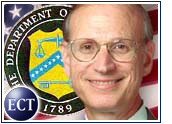
The U.S. Treasury Department announced two e-commerce initiatives Tuesday designed to streamline the process of doing business with the government.
The first effort, called Pay.gov, will be a secure payment and collection portal with the potential to process 80 million transactions each year, worth an estimated $125 billion (US$).
According to Deputy Secretary of the Treasury Stuart Eizenstat, the new system responds “to the increasing demand of individuals and businesses for electronic alternatives.” He added that the department “listened carefully to the needs and concerns of different agencies and built a system that is secure, yet flexible enough to meet them.”
Cutting Red Tape
When Pay.gov launches this fall, citizens, businesses and federal agencies will have the option of processing a wide variety of transactions via the Internet, most of which are currently handled through Automated Clearing House (ACH) collection systems or in-person over the counter.
Transactions set to go digital include government fees, fines, sales, leases, donations, loans and certain taxes. According to Eizenstat, “Citizens will have the choice of interacting with their government by completing forms and applications, making payments, and submitting queries online 24 hours a day, 7 days a week. Businesses will also be able to use cutting edge e-commerce technologies in their dealings with the government.”
Saving Tax Dollars
Developed by the Treasury’s FMS Electronic Money Program Office, Pay.gov will save tax dollars by providing a government-wide central infrastructure for processing e-payments. The government says the new initiative will also reduce Treasury’s collections costs and eliminate paper processing at the Treasury and other federal agencies.
The new Internet portal will also help the government keep better track of its money and allow the Treasury to provide more timely and extensive accounting information to other agencies.
Pay.gov is also expected to help agencies automate the processing of government forms.
Said Eizenstat, “Pay.gov is a critical part of Treasury’s plan to create a 21st century fiscal operation for the U.S. government, and an important step in eliminating barriers to electronic commerce.”
SGLSafe
The government also announced a second e-commerce initiative, known as SLGSafe. Launched in December 1999 and set to be phased in over the next three years, SLGSafe caters to banks and their state and local government customers that invest in State and Local Government Series Securities (SLGS), or special non-marketable Treasury securities designed to meet municipal finance needs.
Although there are currently only 10 banks using the system, the Treasury Department said that there will be some 400 banks online when the rollout is complete. Currently, state and local governments hold approximately $160 billion in SLGS.
“With more than $550 million in securities issued through SLGSafe since December 1999, SLGSafe proves that creative application of technology can benefit state and local governments and Treasury,” Eizenstat said.
E-Government Reality
Pay.gov and SLGSafe are the Clinton administration’s latest efforts to make e-government a reality.
During his first ever Internet address last month, President Clinton announced the creation of a new government portal called Firstgov.gov, which will expedite information delivery to citizens from U.S. government agencies and services that are presently spread across more than 20,000 separate Web sites.












































Social Media
See all Social Media